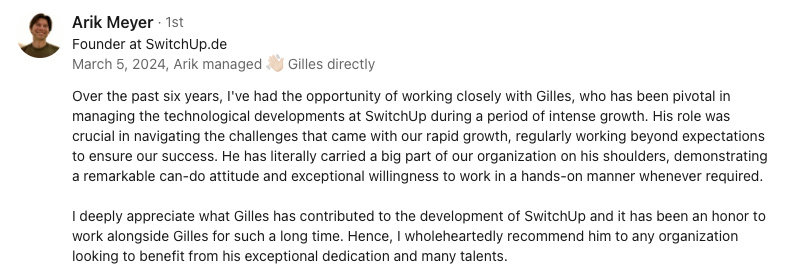Enhancing Data Privacy with Federated Learning
Abstract:
Federated learning is a privacy-preserving approach to artificial intelligence (AI) that allows AI models to be trained on decentralized data, reducing the need for central storage and minimizing the risk of data breaches. This approach is particularly beneficial in industries like healthcare and finance, where data privacy is critical. By training AI models directly on devices where data is generated, sensitive information is kept decentralized and protected. As technology leaders, CTOs and Directors of Technologies should advocate for the adoption of technologies like federated learning to uphold data privacy. Staying informed about emerging privacy-preserving technologies is crucial for maintaining innovation while safeguarding the privacy and security of customers, employees, and partners.
intriguing introduction
Let’s face it, data breaches are the stuff of nightmares for any business these days. We've all heard the horror stories about leaked personal information and the hefty fines that accompany them. Enter federated learning, the unsung hero poised to transform our approach to data privacy.
So what makes federated learning different from its centralized counterparts? Well, instead of pooling all your data into one pot for analysis, federated learning keeps data where it is—safe and sound within local devices. The AI models are trained across several decentralized devices or servers, essentially "learning" without the data ever leaving its original location. This significantly minimizes the risks associated with data breaches, as there’s no centralized honey pot of sensitive information just begging to be hacked.
Picture this: in industries teeming with sensitive data like healthcare and finance, the conventional method of centralizing information can feel like putting all your eggs in one, extremely targetable basket. Federated learning offers a splendid alternative. By decentralizing the data training process, we can enhance privacy without sacrificing the quality or efficiency of our AI models.
Think of federated learning as your undercover data guardian. It's like sending your most valuable secret agents to various locations instead of gathering them all in a single, vulnerable safe house. For tech leaders, this approach isn’t just pie in the sky—it’s a game-changer for maintaining both privacy and competitive edge.
As we progress through this discussion, we’ll spotlight the immense potential federated learning holds for data-sensitive industries and explore how tech visionaries can lead the charge in prioritized data privacy. So, buckle up and stay tuned for some enlightening insights!
advantages of federated learning in data-sensitive industries
Let's roll up our sleeves and look at why federated learning is making considerable waves in industries that handle reams of sensitive data. Think healthcare and finance—sectors where data breaches aren’t just costly, they’re catastrophic. With federated learning, we have a robust solution that promises enhanced privacy, regulatory compliance, and even a more trusting relationship with our customers. Sounds like a win-win, right?
healthcare: a prescription for privacy
In healthcare, patient data is the linchpin of effective treatment, but it's also a double-edged sword. With centralized data storage, a breach could expose millions of personal health records. Federated learning flips the script by enabling AI models to train directly on the devices where data is generated—think hospitals, clinics, and even patients' smartphones—all without the raw data ever leaving its origin.
This decentralized approach isn’t just theoretical; it’s already making a difference. Consider a consortium of hospitals using federated learning to train a predictive model for early detection of rare diseases. Each hospital retains its patient data locally, updating the model periodically by sharing only the learned patterns and parameters. This way, sensitive information stays under each institution’s roof, yet the collective model continuously improves.
One specific example comes from Google Health, which has been experimenting with federated learning to enhance healthcare outcomes. By collectively training models across multiple local datasets, they’ve managed to build robust algorithms for predicting patient deterioration without ever compromising individual privacy.
finance: safeguarding the piggy bank
Data security in the financial sector isn’t just a best practice; it’s a fiduciary responsibility. Financial institutions are treasure troves of sensitive information, making them prime targets for cyberattacks. Federated learning offers a compelling solution by keeping data localized. Banks can train algorithms to detect fraud or predict credit scores right on customers' devices without pooling data into a centralized, and thus more vulnerable, repository.
Take Mastercard for example. They’ve been exploring federated learning to bolster their fraud detection systems. By distributing the data analysis across multiple nodes—each with its unique dataset—Mastercard can create comprehensive, accurate fraud detection models without centralizing sensitive transaction data. This not only mitigates risk but also complies with stringent regulatory requirements, ensuring that they stay on the good side of legislation like GDPR and CCPA.
regulatory compliance: staying ahead of the curve
Speaking of regulations, federated learning ticks all the right boxes. Legislation like the General Data Protection Regulation (GDPR) and the California Consumer Privacy Act (CCPA) mandate stringent data protection measures. Federated learning’s decentralized approach naturally aligns with these regulations by minimizing the risk of data breaches and ensuring that personal data is processed in compliance with local laws.
Take GDPR’s requirement for data minimization, for example. Federated learning’s methodology of retaining data locally ensures minimal data transfer, thus adhering to this principle while still allowing for robust AI model training. It’s like having your cake and eating it too—the best of both worlds.
trust: the intangible asset
Lastly, let’s talk about trust. In an age where consumers are increasingly wary about who has access to their information, federated learning offers transparency and reassurance. When customers know that their data isn’t being pooled into a central, potentially hackable database, trust in the organization naturally increases.
Consider a healthcare provider that clearly communicates its use of federated learning to enhance data privacy. Patients will likely feel more secure sharing their health information, knowing that their data is protected even as it contributes to valuable medical research. Similarly, a bank utilizing federated learning for fraud detection can reassure clients that their transaction data remains private while benefiting from cutting-edge security measures.
So there you have it. Federated learning not only addresses the ever-pressing issue of data privacy but does so in a way that enhances regulatory compliance and fosters trust among customers. In sectors where data sensitivity is paramount, this technology is indeed a game-changer. With practical applications already proving its worth, federated learning is no longer just a buzzword—it's a monumental shift in how we approach data security and privacy.
the role of technology leaders
In my journey as a Chief Technology Officer, I've often found myself at the intersection of innovation and caution. Embracing new technologies while ensuring data security requires a delicate balance, particularly when we're discussing privacy-preserving methods like federated learning. It’s an exciting challenge, one that we as technology leaders face daily.
championing innovation
Let’s not beat around the bush—if we, the CTOs and Directors of Technology, don’t champion these emerging technologies, who will? Our role involves more than just managing existing systems; it's about staying informed and constantly scouting for advancements that more effectively protect our data. Federated learning, with its decentralized approach to data training, is a perfect example of a technology that we should be actively advocating for.
Consider it our responsibility to bring federated learning into the conversation with our leadership teams. We need to present its benefits clearly and concisely, establishing the business case for its adoption. Showcasing tangible improvements in areas such as data privacy, compliance, and customer trust can be persuasive in gaining executive buy-in.
proactive leadership
Playing a proactive role is crucial. To implement federated learning effectively, it’s not just about knowing the tech—it's about understanding how it can fit into and enhance our existing data strategies. For us, this means actively seeking out case studies, research papers, and real-world applications to back up our initiatives. Continual learning and curiosity are our allies.
Moreover, it's imperative that we engage with our teams, listen to their concerns, and address any skepticism about federated learning. By fostering an open dialogue, we can preemptively solve problems and ensure smoother integrations. After all, innovation doesn't happen in a vacuum; it thrives in a collaborative environment.
educating teams and stakeholders
We can’t just implement federated learning and call it a day. Ongoing education is key. Training our teams on this technology's nuances and advantages is vital for sustained success. Regular workshops, webinars, and internal documentation can go a long way toward making federated learning an integral part of our data strategy.
It’s also important to involve stakeholders from various departments—legal, compliance, and even marketing—to ensure that everyone understands how federated learning impacts their specific areas. Think of it as an organizational buy-in for privacy-first innovation. When everyone understands the technical and compliance benefits, we're more likely to see a unified effort in its implementation.
building a culture of privacy
We need to become the torchbearers for privacy within our organizations. Emphasizing a culture that prioritizes data privacy isn't just good ethics; it’s good business. Showcasing federated learning as a critical part of this privacy-first culture can set a precedent for how our teams handle sensitive data.
This means establishing best practices and guidelines that incorporate federated learning's decentralized approach. By integrating these methodologies into our standard operating procedures, we build a robust foundation for long-term data security and privacy.
a call to action for tech leaders
Let’s tackle this head-on: as technology leaders, we have an obligation to not only stay abreast of technological advancements but also to implement those that keep our data secure. Federated learning offers a promising route for enhanced privacy without compromising on the power of our AI models. It's time to take ownership of these initiatives, drive their adoption, and ensure our organizations are on the cutting edge of both technology and privacy.
So, here’s my ask: let’s be the champions of federated learning in our companies. Let’s educate, advocate, and lead the charge in making data privacy a cornerstone of our tech strategy. Together, we can build systems that not only advance our business objectives but also earn the trust and confidence of our customers, employees, and partners. After all, in today’s world, safeguarding privacy isn’t just an option—it’s a necessity.
You might be interested by these articles:
- Navigating Privacy in the Digital Era
- Redefining Care: Datafication's Impact in Healthcare
- The AI Woke Police vs. The Irony Brigade: Can Robots Understand Sarcasm?
- Laughing with AI: Navigating the Ethical Maze of Artificial Humor in Branding
- The Symphony of Creativity in an AI-Powered World





